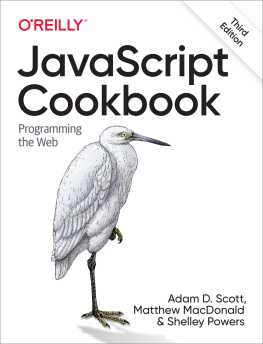Den Odell - Pro JavaScript Development: Coding, Capabilities, and Tooling
Here you can read online Den Odell - Pro JavaScript Development: Coding, Capabilities, and Tooling full text of the book (entire story) in english for free. Download pdf and epub, get meaning, cover and reviews about this ebook. year: 2014, publisher: Apress, genre: Computer. Description of the work, (preface) as well as reviews are available. Best literature library LitArk.com created for fans of good reading and offers a wide selection of genres:
Romance novel
Science fiction
Adventure
Detective
Science
History
Home and family
Prose
Art
Politics
Computer
Non-fiction
Religion
Business
Children
Humor
Choose a favorite category and find really read worthwhile books. Enjoy immersion in the world of imagination, feel the emotions of the characters or learn something new for yourself, make an fascinating discovery.
Pro JavaScript Development: Coding, Capabilities, and Tooling: summary, description and annotation
We offer to read an annotation, description, summary or preface (depends on what the author of the book "Pro JavaScript Development: Coding, Capabilities, and Tooling" wrote himself). If you haven't found the necessary information about the book — write in the comments, we will try to find it.
Pro JavaScript Development is a practical guide for front-end web developers who are experienced at building web pages with HTML, CSS, and JavaScript, and now wish to advance their JavaScript skills to a higher level. You will learn how to build large, well-structured, high quality, mobile-optimized web sites and apps, using the latest supported browser APIs, language features, and tools. This book teaches and shows you in practical hands-on terms how you can:
- Master the performance, reliability, stability, and code manageability of your JavaScript
- Understand and write efficient object-oriented and prototypal code, including full understanding of the this keyword
- Boost the performance of your JavaScript code
- Architect large web applications using common design patterns
- Write high quality JavaScript code and avoid the pitfalls most likely to cause errors
- Manage code dependencies with AMD and RequireJS
- Develop for mobile, build games, and set up a real-time video chat using modern APIs such as Geolocation, Canvas and WebRTC
- Document your code as the professionals do
- Write command-line and web server applications in JavaScript with Node.js,
- Use build tools, such as Grunt and Gulp, to automate repetitive tasks and improve your development workflow
Using real-world examples and applications that youll build yourself, Pro JavaScript Development has unique, practical content that will make you a better JavaScript developer. Become a master of the latest JavaScript coding techniques and tools, and harness its best capabilities today.
What youll learn- To build faster and more efficient web apps using the latest techniques
- How to select the best libraries and frameworks for each project based on design patterns and sound principles
- To manage JavaScript objects with inheritance through the prototype property and the this keyword
- To unit test your JavaScript, to measure and improve the quality of your code
- To create your own web server using Node.js, featuring real-time bidirectional communication with web sockets
This book is intended for the front-end web developer who is already using JavaScript but wants to know what tools, and techniques they can use to enhance their development. You want to create better apps, better sites, with the best and latest skills.
Table of Contents- Object-Oriented JavaScript
- Documenting JavaScript Code
- Writing High-Quality JavaScript
- Boosting JavaScript Performance
- Design Patterns: Creational
- Design Patterns: Structural
- Design Patterns: Behavioral
- Design Patterns: Architectural
- Managing Code File Dependencies
- Mobile JavaScript Development
- Building Games with Canvas API
- Using WebRTC for Video Chat
- Using Client-Side Templates
- The Node.js Application Platform
- Build Tools and Automation
- Browser Developer Tools
Den Odell: author's other books
Who wrote Pro JavaScript Development: Coding, Capabilities, and Tooling? Find out the surname, the name of the author of the book and a list of all author's works by series.












